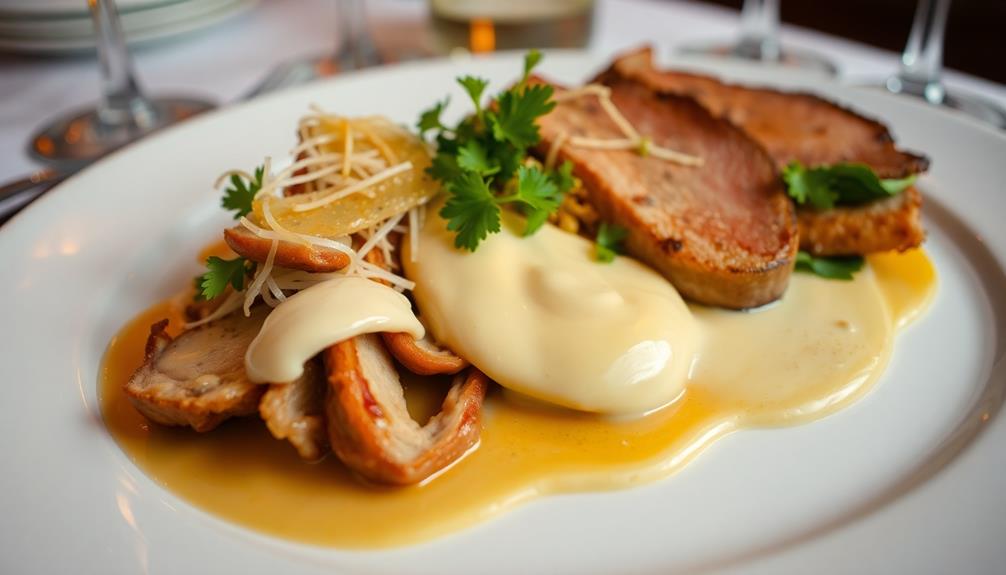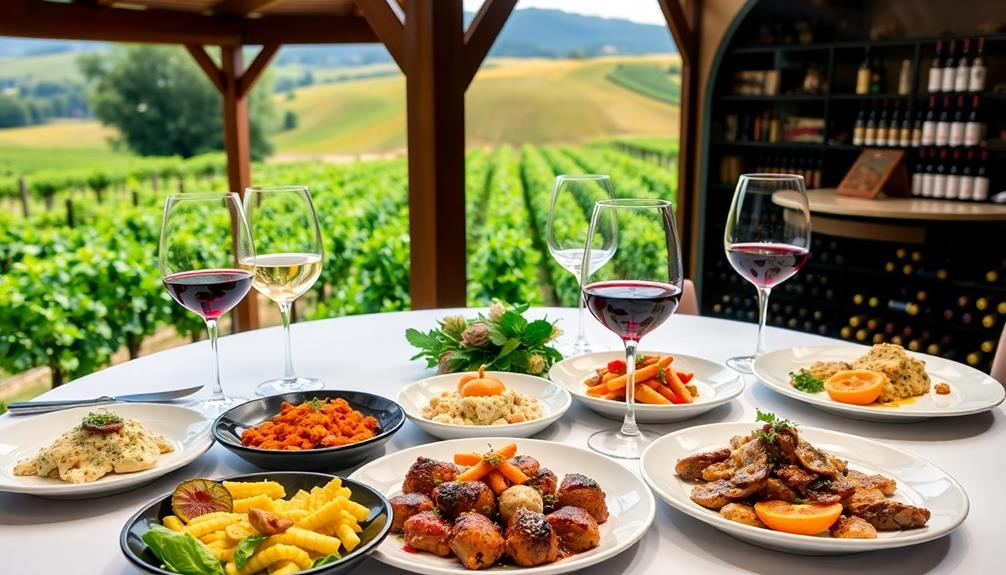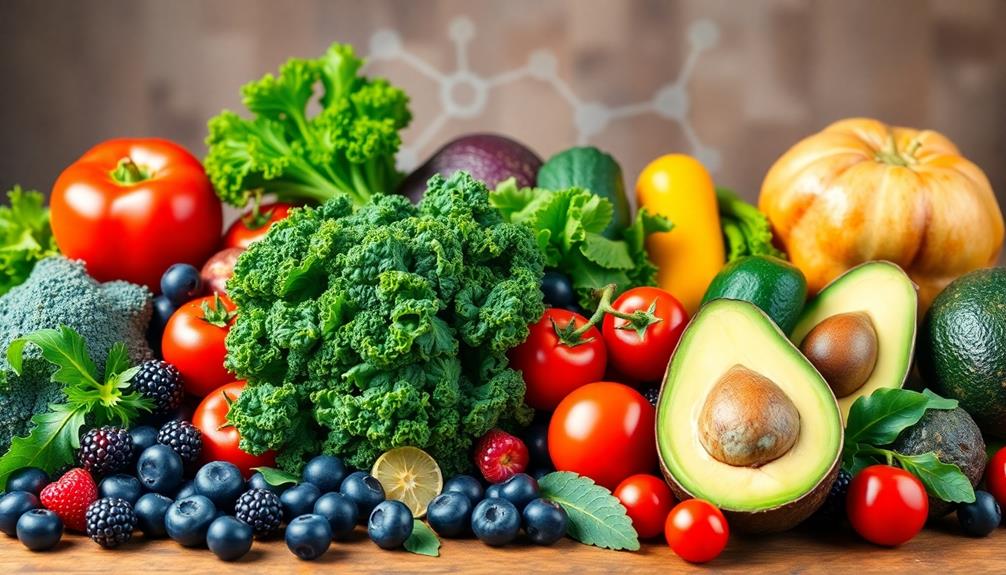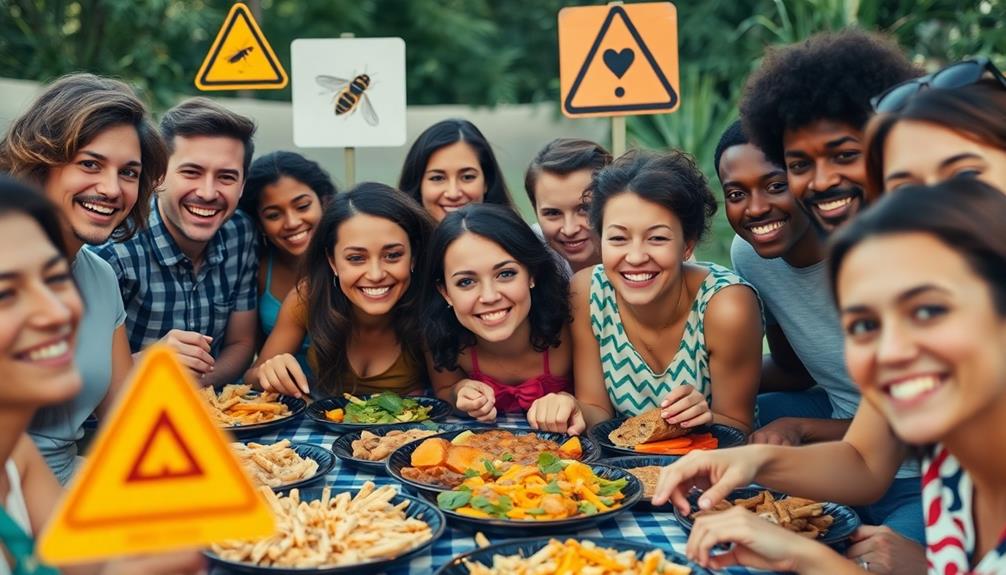Food memories form in your brain through emotional connections tied to taste and smell. When you eat, your hippocampus and amygdala activate, linking specific flavors with vivid experiences. The scents and tastes encountered trigger nostalgic feelings, shaping how you recall meals. Childhood meals often hold the most significance, influencing your preferences over time. Repeated exposure to certain foods strengthens these memory pathways. Cultural traditions also play a role, as shared meals create lasting bonds. If you think about your own experiences, you'll see how deeply food impacts your memories and emotions. There's so much more to explore!
Key Takeaways
- The hippocampus encodes emotional and contextual elements of food experiences, aiding in the formation of long-term memories.
- Taste and smell work together to enhance flavor experiences, creating strong emotional and memory associations.
- Dopamine release from pleasurable foods, like chocolate, reinforces positive feelings and strengthens memory retention.
- The amygdala links emotional responses to specific foods, influencing how memories of those foods are recalled.
- Childhood food memories, shaped by social interactions and family traditions, promote lasting emotional connections and nostalgia.
Emotional Power of Taste and Smell

Imagine biting into a warm slice of homemade apple pie, the sweet aroma wafting through the air. That moment isn't just about flavor; it's a powerful emotional experience.
Taste and smell are intricately linked, traveling through the same airway, which creates a simultaneous sensory delight. When you savor that pie, your brain's hippocampus springs into action, forming long-term memories tied to the experience.
Just like the delightful experience of enjoying Dorayaki (Red Bean Pancake), each bite activates emotional regions in your brain, connecting flavors with vivid memories. You might recall family gatherings, laughter, or even a cherished friend.
This biological wiring enhances your ability to remember and feel, making food a potent trigger for emotions. The olfactory bulb plays an essential role here, distinguishing flavors and processing memories, underscoring how smell can evoke strong feelings linked to food.
Food's Role in Positive Associations

Food plays an essential role in shaping your emotional connections and building relationships. When you share a delicious meal or treat, those flavors create lasting memories that strengthen bonds with others.
For instance, enjoying traditional dishes like Caldeirada or sweets such as Brigadeiro can evoke feelings of comfort and nostalgia. Whether it's a celebratory event or a casual meeting, the right food can turn ordinary moments into meaningful experiences.
Emotional Connections Through Flavor
When you savor a favorite dish, the intertwined sensations of taste and smell ignite powerful emotional connections. The brain processes these two senses through the same airway, amplifying your experience of food. This connection plays a significant role in forming lasting memories, particularly in the hippocampus, which helps you recall not just the flavors but the emotions tied to them.
For instance, the rich flavor of Red-Braised Pork Belly can evoke memories of family gatherings and celebrations, further enhancing the emotional ties to the meal.
Think about the last time you enjoyed a gourmet snack. The pleasure you felt stimulated your brain's reward mechanisms, creating positive associations that make you want to repeat the experience. Foods like chocolate, known for their mood-boosting properties, release dopamine, mimicking feelings of euphoria and reducing stress.
This emotional significance enhances your enjoyment and connection to that particular food.
Memorable culinary experiences don't just impact you personally; they also strengthen relationships in professional settings. Sharing a flavorful meal can boost employee morale and reinforce client connections, showcasing the strategic importance of food in fostering positive associations.
Food as Relationship Builder
Sharing a delicious meal can transform an ordinary gathering into a memorable experience, forging stronger bonds among participants. For instance, enjoying traditional dishes like Chilaquiles or Quesadillas can create a warm and inviting atmosphere, enhancing the overall enjoyment of the occasion.
When you indulge in gourmet snacks, you're not just savoring flavors; you're activating your brain's reward mechanisms. This connection enhances positive associations, especially during business interactions. In-person meetings enriched with taste experiences often lead to more impactful connections, making your relationships with clients and colleagues even stronger.
Positive food experiences, like shared meals or celebratory events, encourage follow-up actions and enhance client loyalty. You may find that a well-timed food gift—whether it's a box of high-quality chocolates or customized snacks—creates lasting impressions and fosters a positive workplace culture.
Imagine the joy of sharing candy as a pathway to deeper connections, where every sweet bite reinforces trust and camaraderie.
Strategic use of snacks in corporate settings not only boosts employee morale but also differentiates your organization through memorable food experiences. By prioritizing these shared moments, you cultivate an environment where relationships flourish, proving that food truly is a powerful relationship builder.
Childhood Memories and Food

Many people cherish their childhood food memories, often tied to emotional connections that linger long after the meals are gone. These memories are deeply rooted in the brain, particularly within the hippocampus, which plays an essential role in forming long-term memories associated with significant life events. If you had a sweet tooth as a child, the sweetness of candies likely stimulated your brain's reward centers, enhancing the vividness of those memories.
Engaging in cooking with family not only creates lasting bonds but also fosters creativity and skills that shape future culinary preferences. Positive food experiences often trigger nostalgia, promoting happiness and reinforcing connections with loved ones. Here's a quick overview of how food memories from childhood can impact you:
| Memory Type | Emotional Impact | Lasting Effects |
|---|---|---|
| Sweet Treats | Happiness & Nostalgia | Stronger Family Bonds |
| Family Meals | Connection & Joy | Culinary Preferences |
| Cooking Together | Skill Development | Healthier Eating Habits |
These cherished moments can lead to healthier eating habits, as you develop a deeper understanding of nutrition and culinary heritage.
The Science of Flavor Processing

Flavor processing is a fascinating interplay of sensory experiences that shapes how you perceive and remember food. When you enjoy a meal, your taste buds and olfactory senses work together, sending signals through the olfactory bulb to create a rich perception of flavor. This integration enhances your memory recall associated with food, making it easier for you to remember the experience.
For instance, the rich blend of spices in dishes like Mushroom Masala can create vivid memories tied to their unique flavors. The hippocampus plays an essential role in forming long-term memories of these flavors, encoding emotional and contextual elements. Meanwhile, the amygdala activates during flavor experiences, linking emotional responses to specific foods and strengthening the association between flavor and memory.
Sweetness, in particular, triggers your brain's reward mechanisms, releasing dopamine that not only brings pleasure but also helps convert short-term memories into long-term ones.
Moreover, hormones like ghrelin regulate appetite and influence memory formation by affecting your brain's reward systems. This connection between flavor, emotional salience, and memory guarantees that each meal leaves an imprint on your brain, making food memories rich and enduring. This interplay is especially evident in the science of pregnancy food cravings, where heightened hormonal shifts can amplify the emotional and sensory associations with certain foods. These cravings not only reflect physiological needs but also contribute to forming deeply rooted food memories that can resurface long after the pregnancy ends. Such insights underline how our brain weaves a tapestry of flavors, emotions, and experiences that shape our lifelong relationship with food.
Understanding this science reveals why certain flavors can evoke powerful recollections and feelings, deeply intertwining food with your life experiences.
Evolution of Food Memory

As humans evolved, the way we remember food became just as important as the food itself. Early humans relied on foraging and sweet fruits, which activated the brain's reward systems, enhancing food memories. This was vital for survival, as dopamine released during these experiences reinforced behaviors related to food seeking and consumption.
With the advent of agriculture around 10,000 years ago, our food engagement transformed. This shift led to more complex food memories tied to communal practices and social events. The hippocampus and amygdala play significant roles in storing these emotional and episodic memories, emphasizing our biological wiring for taste-related recollections.
Here's a quick overview of food memory evolution:
| Time Period | Key Development | Impact on Food Memories |
|---|---|---|
| Early Humans | Foraging for sweet fruits | Activation of reward mechanisms |
| Agricultural Era | Cultivation of cereals | Creation of complex communal memories |
| Modern Era | Cultural practices around food | Lasting associations with social events |
These developments show how food memories are integral to human experience, shaping not just our survival but also our social structures.
Cultural Significance of Food Experiences

Food experiences serve as powerful vessels for cultural expression, weaving together memories, traditions, and communal bonds. Each meal shared, especially those with unique textures like hard chewiness, becomes more than just food; it transforms into a symbol of your cultural identity.
For instance, dishes like Kawarma offer rich flavors that enhance the communal dining experience, creating lasting impressions. The emotional connections formed during these culinary activities not only enhance memory retention but also shape who you are.
Consider how food experiences contribute to cultural significance:
- Commemoration: Meals often mark important events, creating lasting memories.
- Tradition: Family recipes link generations, reinforcing a sense of belonging.
- Rituals: Holiday meals and gatherings tell shared cultural narratives.
- Nostalgia: Specific tastes and textures evoke memories, helping you reconnect with your roots.
- Community: Shared meals foster bonds, creating a sense of unity and identity.
In every bite, from a chewy piece of bread to a tender dish, you engage in a rich tapestry of history and belonging.
These food experiences resonate deeply within you, enriching your understanding of culture and enhancing your connection to others.
The Impact of Chocolate on Mood

When you enjoy chocolate, you're not just treating your taste buds; you're also boosting your mood. The compounds in chocolate can trigger feelings of euphoria, creating a strong emotional connection to those sweet moments.
This connection can be particularly profound when associated with comforting Southern foods, such as Chocolate Gravy, which evokes warm memories of family breakfasts.
Plus, chocolate's delightful flavor can help you remember happy experiences, linking pleasure with memory in a unique way.
Mood-Boosting Compounds in Chocolate
Chocolate's allure goes beyond its rich flavor; it's packed with mood-boosting compounds that can elevate your spirits. When you indulge in chocolate, you're not just treating your taste buds; you're also triggering powerful emotional responses in your brain.
Just as traditional Ethiopian foods like Yekolo can evoke memories of communal gatherings, chocolate can transport you back to joyful moments with its comforting taste. Here's how it works:
- Phenylethylamine mimics opioids, leading to feelings of euphoria and pleasure.
- Theobromine enhances your mood, providing a gentle lift.
- Consuming chocolate releases dopamine, helping alleviate stress and anxiety.
- The sugar in chocolate activates your brain's reward centers, reinforcing positive feelings.
- Dark chocolate, rich in flavonoids, improves mood and cognitive function.
Each bite can transport you back to joyful memories, making chocolate not just a sweet treat but a powerful emotional connector.
As you savor its taste, your brain associates chocolate with comfort and happiness, enhancing your overall well-being.
Emotional Connections to Chocolate
Indulging in chocolate creates strong emotional connections that can profoundly impact your mood. When you savor a piece of chocolate, your sense of taste engages in a delightful dance, triggering the release of dopamine—your brain's pleasure neurotransmitter. This not only elevates your mood but also helps reduce stress levels.
The compounds found in chocolate, like phenylethylamine, mimic the effects of endorphins, enhancing feelings of happiness and well-being. Similarly, the enjoyment of traditional Greek foods, such as Horiatiko Psomi, can evoke strong feelings of nostalgia and comfort, further illustrating the emotional power of food.
Many people turn to chocolate during tough times, finding comfort in its rich flavors. Studies show that chocolate can alleviate feelings of anxiety and depression, making it a go-to choice for emotional relief. The sensory experience of enjoying chocolate, including its enticing aroma, can evoke positive memories, further deepening your emotional bond with this beloved treat.
Additionally, regular consumption of chocolate, especially dark chocolate, is linked to improved cognitive function and emotional resilience. With its high antioxidant content and mood-boosting properties, chocolate becomes more than just a sweet indulgence; it's a powerful ally in enhancing your emotional state.
Chocolate's Role in Memory
As you enjoy a piece of chocolate, your brain responds with a rush of dopamine, enhancing your mood and creating a lasting impression on your memory. This delightful experience isn't just a fleeting moment; it can influence how you remember events tied to chocolate consumption.
For instance, sharing a delicious treat like Graveyard Taco Dip at a Halloween party can create joyful memories that are associated with the flavors and company present during that time.
Here are some key ways chocolate impacts your mood and memory:
- Dopamine Release: Chocolate consumption triggers dopamine, improving your mood and making you feel happier.
- Flavonoids: These compounds mimic opioid responses in your brain, enhancing feelings of pleasure and contentment.
- Stress Reduction: Enjoying chocolate leads to lower stress levels, forming positive associations with it.
- Memory Retention: Positive experiences with chocolate can help solidify emotional memories connected to those moments.
- Social Enjoyment: Sharing chocolate at events boosts overall satisfaction, making those experiences memorable.
Sensory Stimulation and Memory Care

Engaging the senses through familiar tastes and smells can greatly enhance memory recall for individuals with Alzheimer's and dementia. Sensory stimulation, particularly through food, plays an essential role in improving mood and cognitive function. When you combine taste, smell, and sight during mealtime, you create a rich experience that strengthens memory recall.
Here's a table to illustrate the impact of sensory stimulation through food:
| Sensory Element | Impact on Memory Care |
|---|---|
| Taste | Evokes nostalgia and comfort |
| Smell | Triggers emotional responses |
| Sight | Enhances appetite and enjoyment |
| Texture | Promotes engagement and satisfaction |
| Presentation | Increases overall mealtime experience |
Understanding each individual's unique food preferences and sensory triggers is vital. This personalized approach not only makes mealtime more enjoyable but also promotes emotional well-being. By focusing on familiar and comforting foods, you can provide a therapeutic experience that encourages memory recall and enriches the lives of those experiencing memory loss. So, make mealtime a sensory journey and watch it transform memory care.
Practical Applications of Food Memories

Food memories can be a powerful tool in both personal and professional settings. By leveraging these memories, you can foster connections and enhance experiences for yourself and others.
Here are some practical applications of food memories:
- Boost Workplace Culture: Incorporating positive food experiences can enhance morale, leading to increased productivity.
- Memorable Corporate Events: Use gourmet snacks to create lasting impressions and emotional connections among participants.
- Flavor Science: Understand that enjoyable food boosts dopamine levels, aiding in memory retention and recall.
- Customized Food Gifts: Tailor food offerings to create lasting impressions, reinforcing brand loyalty.
- Client Relationships: Use food memories to build emotional ties, making clients feel valued and appreciated.
Frequently Asked Questions
How Do We Create Memories With Food?
You create memories with food through shared experiences, emotional connections, and the flavors that resonate with you. Each meal, with its unique tastes and scents, can spark nostalgia and strengthen bonds with loved ones.
Why Do Foods Bring Back Certain Memories?
Foods bring back certain memories because they're tied to emotions and experiences. When you taste something familiar, it often triggers feelings of nostalgia, reminding you of special moments, family gatherings, or childhood delights you cherish.
What Part of the Brain Remembers Food?
Your brain's hippocampus and amygdala dance together, weaving memories of food experiences. They help you recall flavors and emotions, while the olfactory bulb sparks vivid recollections, making every meal a flavorful journey through time.
How Does Food Evoke Memories?
Food evokes memories by triggering emotions and sensations tied to past experiences. When you taste a familiar dish or smell a favorite treat, those feelings can transport you back to cherished moments and connections.
Conclusion
In the grand tapestry of your life, food memories weave vibrant threads of joy and nostalgia. Each flavor and aroma dances like a cherished song, transporting you back to moments filled with laughter and warmth. As you savor a meal, remember that it's not just about taste; it's the emotions and experiences that linger long after. Embrace these connections, and let your palate guide you through the vivid landscapes of your past, enriching your present and future.










